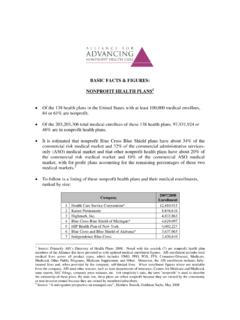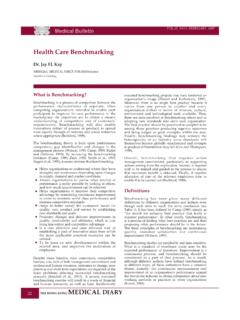Transcription of Introduction to Health care accounting and financial ...
1 Jones & Bartlett Learning, LLC. NOT FOR SALE OR DISTRIBUTION. Chapter 1. Introduction to Health care accounting and financial Management Do I Really Need to It is clear that not everyone will become the Understand Account- chief financial officer, but everyone is mak- ing to Be an Effective ing financial decisions and needs to be able Health care Manager? to communicate effectively with financial managers. Today's Health care system, with its many types of Health care organizations, is extremely complex. The science of Health care , the What Is financial Management?
2 Physical maintenance of facilities, and the interactions and human behaviors within the This book focuses on Health care account- organizations are complex, as are the finan- ing and finance (Figure 1-1). accounting is a cial and accounting requirements. The com- system for providing financial information. plexity of today's environment has resulted It is generally broken down into two prin- in the spread of accounting and financial cipal elements: financial accounting and management to all areas within a Health care managerial accounting . Finance has tradi- organization.
3 accounting and financial man- tionally been thought of as the area of finan- agement are no longer the sole purview of cial management that supervises the acqui- the finance department. Nurse-managers are sition and disposition of the organization's held responsible for the financial manage- resources, especially cash. ment of their units; pharmacy directors are making significant financial management decisions on a daily basis; and operating room (OR) managers must maintain efficient utili- accounting and Finance zation rates, as well as keeping patients flow- ing through the OR, to maintain the financial Health of the organization.
4 accounting Finance To be successful, Health care managers and executives, regardless of the specific financial Managerial area within a Health care organization they accounting accounting lead, must all have a firm understanding of accounting and financial management. Figure 1-1 accounting and Finance 1. 1 11/4/11 1:35:38 PM. Jones & Bartlett Learning, LLC. NOT FOR SALE OR DISTRIBUTION. 2 accounting Fundamentals for Health care Management The financial accounting aspect of account- services, and minimizing morbidity and ing is a formalized system designed to record mortality.
5 For many Health care organiza- the financial history of the Health care orga- tions ( , not-for-profit hospitals), maxi- nization. The financial accountant is simply mization of profit may not be a goal at all, a historian who uses dollar signs. An inte- although at least some profit is usually nec- gral part of the financial accountant's job essary to ensure the financial well-being of is to report the organization's history from even these organizations. time to time to interested individuals, usu- On a more personal level, managers are ally through the organization's quarterly concerned with maximization of salaries and and annual reports.
6 Benefits. In a for-profit organization, such The managerial accountant looks forward; maximization is often tied in with the maxi- the financial accountant looks backward. mization of return on investments (ROI), Instead of reporting on what has hap- return on equity (ROE), return on assets pened, the managerial accountant provides (ROA), or return on net assets (RONA; see financial information that might be used Chapter 14). The list of goals within the for making improved decisions regard- organization is relatively endless. ing the future. In many organizations the From the perspective of financial manage- same individual is responsible for providing ment, there are two overriding goals: profit- both financial and managerial accounting ability and viability (Figure 1-2).
7 The orga- information. nization wants to be profitable, and it wants The role of finance has expanded sig- to continue doing business. It is possible to nificantly from the functions of borrowing be profitable, yet fail to be able to continue funds and investing excess cash resources of in business. Both goals require some clari- the firm. In its broader sense, the finance fication and additional discussion, because function involves providing financial anal- these goals surface throughout this book. yses to improve decisions that affect the wealth of the organization.
8 Whereas the Profitability managerial accountant provides the infor- mation for use in the analyses, the finance As stated, many Health care organizations officer often performs the actual analyses. do not have maximization of profit as a goal, but even those organizations must generate What Are the Goals of Finan- some level of profit to achieve their other cial Management Within goals. Whether for-profit or not-for-profit, Health care Organizations? Health care organizations need profits to invest in expansion of services so there is At first, one might say that the goal of finan- wider access to Health care .
9 They also need cial management is to aid in the maximiza- tion of wealth, or more simply, the maximi- zation of the organization's profits. Profits Organizational are, after all, literally, the bottom line. Goals However, the Health care environment has many other goals for example, improving Profitability Viability the Health and well-being of the community, providing the highest quality Health care Figure 1-2 Organizational Goals 2 11/4/11 1:35:38 PM. Jones & Bartlett Learning, LLC. NOT FOR SALE OR DISTRIBUTION. Chapter 1: Introduction to Health care accounting and financial Management 3.
10 To earn profits on some patients in order to Consider keeping funds in a passbook subsidize those patients who are unable account insured by the Federal Deposit to bear the costs of their services. Health Insurance Corporation (FDIC). You might care organizations need profits to acquire earn a profit or return (in nominal terms . new technologies to improve the quality of we'll talk about inflation later) of less than Health care . Further, Health care organiza- 2%. This return is low, but so is the risk. tions need to earn profits in order to have Alternatively, you could put your money money available should an emergency arise.

















